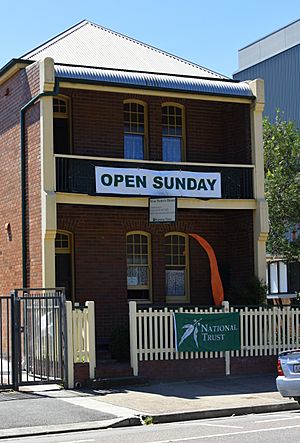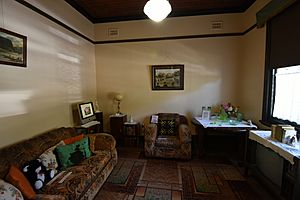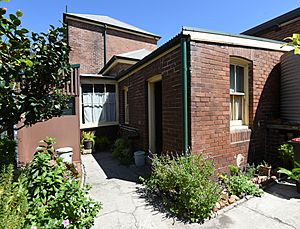Miss Porter's House facts for kids
Quick facts for kids Miss Porter's House |
|
|---|---|
 |
|
| Location | 434 King Street, Newcastle West, Newcastle, City of Newcastle, New South Wales, Australia |
| Owner | National Trust of Australia (NSW) |
| Official name: Miss Porter's House | |
| Type | state heritage (built) |
| Designated | 17 November 2000 |
| Reference no. | 1445 |
| Type | House |
| Category | Residential buildings (private) |
| Builders | J T Owen |
| Lua error in Module:Location_map at line 420: attempt to index field 'wikibase' (a nil value). | |
Miss Porter's House is a special historic home that is now a house museum. It is located at 434 King Street in Newcastle, Australia. For almost 90 years, it was the home of the Porter family. Today, it is owned by the National Trust of Australia and is a protected heritage site. Visiting the house is like stepping back in time.
Contents
The Porter Family's Story
The story of this house begins with a young man named James Porter. He moved from England to Australia in the 1860s. He started a family and became a successful store owner in Newcastle.
Building a Family Home
In 1907, James Porter bought a piece of land. He gave part of it to his son, Herbert. In 1909, Herbert and his new wife, Florence, were ready to start their own family. They hired a builder named John T. Owen to build them a house. The house was finished in December 1909.
The house was built in the Edwardian style. It was a lovely family home in an area that was mostly industrial. Across the street were buildings for a gas company, and nearby were markets and the homes of market gardeners. Over the years, the area changed, but Miss Porter's House remained the only home.
Life in the House
Herbert and Florence began to furnish their new home. In 1911, their first daughter, Ella, was born. A "bush house," which is like a shaded porch for plants, was added to the property that same year. A few years later, their second daughter, Hazel, was born.
Sadly, life changed for the family after World War I. A terrible influenza epidemic spread across the world, and Herbert Porter passed away in 1919. He was only 41 years old. Florence was left to raise her two young daughters, Ella and Hazel, on her own.
The Porter Sisters
Florence worked hard to take care of her family. Ella and Hazel went to Cooks Hill Public School, just like their father had. After finishing school, both sisters worked in offices in Newcastle.
A very exciting time for the family was in 1949. A big Australian movie called "Eureka Stockade" was filmed near their family's old farm. The Porter women went to watch the filming and meet the actors, including the famous Australian actor Chips Rafferty. They kept photos and newspaper clippings from this special event.
Ella and Hazel never married and lived in the house their entire lives. Their mother, Florence, lived with them until she passed away in 1970 at the age of 91. The sisters continued to live together in their family home. Ella passed away in 1995, and Hazel passed away in 1997.
Before she died, Hazel decided to give the house and everything in it to the National Trust of Australia. She wanted the home to be preserved so that others could see what life was like for her family.
A House Frozen in Time
Miss Porter's House is special because it is a complete time capsule. The house, the furniture, and all the family's belongings are still there. It shows what life was like for a middle-class family in the early 20th century.
What's Inside?
The house is a two-story brick home with a balcony. Inside, you can see beautiful decorations from when the house was first built and from updates made in the 1930s. There are stencilled timber ceilings, a beautiful wooden staircase, and patterned linoleum floors.
The sitting room has a velvet lounge suite that Florence bought in 1939. The large dining room is filled with furniture that Herbert bought in 1909. From the dining room, you can go out to a verandah and the "bush house," which was a lovely outdoor living space for the family.
The house also has a kitchen with a large fireplace, a small kitchenette, a bathroom, and a laundry. The small backyard has a water tank and a garden.
Surviving an Earthquake
On December 28, 1989, a powerful earthquake hit Newcastle. Miss Porter's House was badly damaged. Bricks had fallen off the outside, and the balcony roof had collapsed. Soot and dust covered everything inside.
Some people thought the house should be torn down, but Ella and Hazel wanted to save their home. An architect named Don Barnett helped them rebuild it for free. During the repairs, the sisters decided to add a modern indoor toilet to the bathroom.
Why Is This House Important?
Miss Porter's House is a protected heritage site because it is a rare and complete example of a family home from its time.
- History: It tells the story of one family living in Newcastle for 90 years. It shows how they lived, worked, and faced challenges.
- Design: The house has beautiful and well-preserved features from the Edwardian and Art Deco periods. The stencilled ceilings and original furniture are amazing to see.
- Collection: The house contains thousands of the family's personal items, including clothes, documents, and household goods. This collection helps us understand the daily lives of the Porter family.
Today, volunteers from the National Trust take care of the house and its collection. They open it to the public so everyone can experience this unique piece of Australian history.
Images for kids





